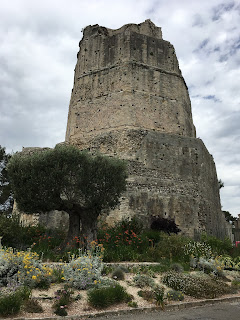Nîmes: Bullfights and Crocodiles
 |
| Romans put crocodiles on the first Nîmes coins |
I always associated bull fighting with Spain and Hemingway novels. I didn’t know the French did bull fights until I visited Nîmes. Scattered across southern France are various arenas, some built by the Romans, others built later, and every summer the arenas host bull fights during féria, which are street fairs that dominate towns for several days. Another fun fact about Nîmes I learned is the word "denim" means "from Nîmes (de Nîmes).
There is a direct TGV train from Montpellier to Nîmes that takes 30 minutes. The esplanade between the station and the tourist office
I arrived in the early morning and stopped to get breakfast before venturing over to the Arena. I had my coffee, croissant, and orange juice outside, and I noticed across the street large tents with beer taps, counters, refrigerators, and pictures of bulls.
Festival). Included in the activities were several bullfighting events at the Arena.
The Romans built the Nîmes Arena around 95 A.D., and it’s one of the best-preserved. The pre-recorded audio guide I rented from the ticket counter explained the word “arena” means “sand,” and the Romans used sand because it was good for covering up
 |
| Nîmes Arena hosts bullfights and live concerts |
So, why sand? Between chariot races in the morning and gladiator fights in the afternoon, most of the audience would leave to get food (a sort of halftime), and that's when convicted criminals and religious prisoners, such as Christians, were fed to the lions. The
ritual was so dreadful, according to Roman philosopher Seneca, that some prisoners killed themselves before being sent to the arena.
Luckily, there’s little, if any, blood spilled in France’s arenas today. Whenever I asked locals about bullfighting, they made sure I understood that, unlike in Spain, the bulls are not killed. That doesn’t mean it’s safe, though. After I returned to Sacramento, I read in the online version of Midi Libre that a matador from Béziers, Tomas Cerqueira, was gravely injured during a bullfight in Mauguio.
From the Arena, I walked north in the direction of the Jardins de la Fontaine. That was where the Tour Magne was located. Along the
 |
| Jardins de la Fontaine |
The Tour Magne was built on one of the highest points in Nîmes in 15 A.D. and, thanks to a Nostradamus prophesy, it was nearly destroyed in the 12th century. A nurseryman named François Traucat was convinced Nostradamus was referring to the Tour Magne when he spoke of "gleaming metals of the Sun and Moon," so he got permission from Henry IV
 |
| Tour Magne |
On the way back to the station, I had to find a place for lunch, and I also wanted to visit both the Natural History Museum and the Archeological Museum. I found a cute family-run restaurant immediately next to the museums and ordered a set menu with homemade paté, fish stew, beer, and dessert.
 |
| Taxidermy collection |
 |
| Excited to see a visitor! |
 |
| Greek tombstones in Archeological Museum |
 |
| Inside the Tour Magne |
 |
| View from atop the Tour Magne |






Comments
Post a Comment